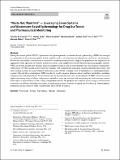| dc.contributor.author | Erickson, Timothy B. | |
| dc.contributor.author | Endo, Noriko | |
| dc.contributor.author | Duvallet, Claire | |
| dc.contributor.author | Ghaeli, Newsha | |
| dc.contributor.author | Hess, Kaitlyn | |
| dc.contributor.author | Alm, Eric J | |
| dc.contributor.author | Matus, Mariana | |
| dc.contributor.author | Chai, Peter R. | |
| dc.date.accessioned | 2021-08-26T15:53:15Z | |
| dc.date.available | 2021-08-26T15:53:15Z | |
| dc.date.issued | 2021-08 | |
| dc.date.submitted | 2021-06 | |
| dc.identifier.issn | 1556-9039 | |
| dc.identifier.issn | 1937-6995 | |
| dc.identifier.uri | https://hdl.handle.net/1721.1/131209 | |
| dc.description.abstract | During the current global COVID-19 pandemic and opioid epidemic, wastewater-based epidemiology (WBE) has emerged as a powerful tool for monitoring public health trends by analysis of biomarkers including drugs, chemicals, and pathogens. Wastewater surveillance downstream at wastewater treatment plants provides large-scale population and regional-scale aggregation while upstream surveillance monitors locations at the neighborhood level with more precise geographic analysis. WBE can provide insights into dynamic drug consumption trends as well as environmental and toxicological contaminants. Applications of WBE include monitoring policy changes with cannabinoid legalization, tracking emerging illicit drugs, and early warning systems for potent fentanyl analogues along with the resurging wave of stimulants (e.g., methamphetamine, cocaine). Beyond drug consumption, WBE can also be used to monitor pharmaceuticals and their metabolites, including antidepressants and antipsychotics. In this manuscript, we describe the basic tenets and techniques of WBE, review its current application among drugs of abuse, and propose methods to scale and develop both monitoring and early warning systems with respect to measurement of illicit drugs and pharmaceuticals. We propose new frontiers in toxicological research with wastewater surveillance including assessment of medication assisted treatment of opioid use disorder (e.g., buprenorphine, methadone) in the context of other social burdens like COVID-19 disease. | en_US |
| dc.description.sponsorship | NIH (Grant R44 DA051106-01) | en_US |
| dc.publisher | Springer Science and Business Media LLC | en_US |
| dc.relation.isversionof | http://dx.doi.org/10.1007/s13181-021-00853-4 | en_US |
| dc.rights | Creative Commons Attribution 4.0 International license | en_US |
| dc.rights.uri | https://creativecommons.org/licenses/by/4.0/ | en_US |
| dc.source | Nature | en_US |
| dc.title | “Waste Not, Want Not” — Leveraging Sewer Systems and Wastewater-Based Epidemiology for Drug Use Trends and Pharmaceutical Monitoring | en_US |
| dc.type | Article | en_US |
| dc.identifier.citation | Erickson, Timothy B. et al. '“Waste Not, Want Not” — Leveraging Sewer Systems and Wastewater-Based Epidemiology for Drug Use Trends and Pharmaceutical Monitoring.' Journal of Medical Toxicology (August 2021): dx.doi.org/10.1007/s13181-021-00853-4. © 2021 The Author(s) | en_US |
| dc.contributor.department | Massachusetts Institute of Technology. Department of Biological Engineering | en_US |
| dc.contributor.department | Singapore-MIT Alliance in Research and Technology (SMART) | en_US |
| dc.contributor.department | Koch Institute for Integrative Cancer Research at MIT | en_US |
| dc.relation.journal | Journal of Medical Toxicology | en_US |
| dc.eprint.version | Final published version | en_US |
| dc.type.uri | http://purl.org/eprint/type/JournalArticle | en_US |
| eprint.status | http://purl.org/eprint/status/PeerReviewed | en_US |
| dspace.date.submission | 2021-08-23T14:22:57Z | |
| mit.license | PUBLISHER_CC | |
| mit.metadata.status | Complete | en_US |
